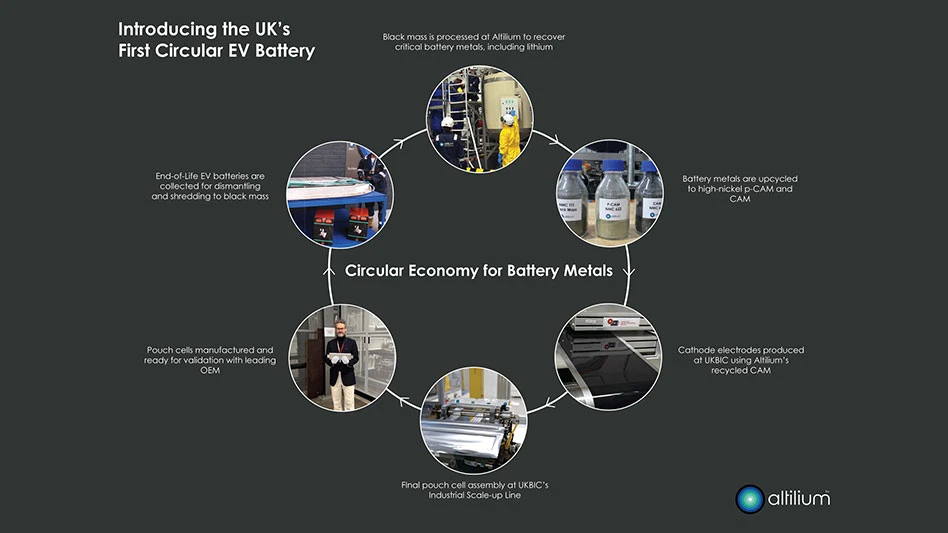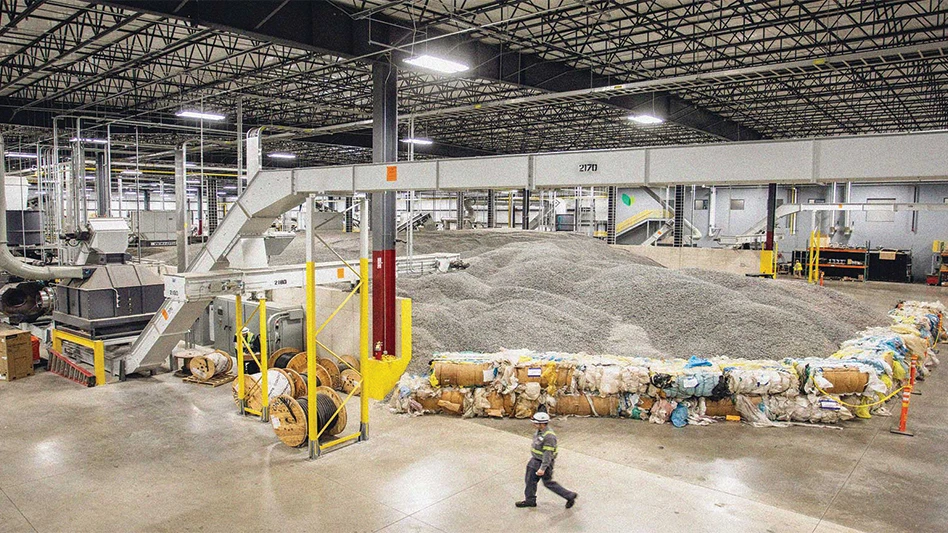Recyclers gathered in Los Angeles April 5-9 to discuss the various trends affecting the many sectors of the recycling industry at the 2011 Institute of Scrap Recycling Industries (ISRI) Convention & Exposition. The event, which took place at the Los Angeles Convention Center, was the second largest in the association’s history, according to its organizers, with attendance reaching more than 4,000.
The event’s theme, “Action,” was a tribute to L.A.’s film industry, but it also was meant to encourage recyclers to take action to improve their businesses and take their operations to the next level.
In addition to programming that included spotlights on various secondary commodities and sessions on Superfund liability, the state of the electronics recycling industry and dust control, the convention offered an exhibit hall featuring nearly 300 equipment and service suppliers to the recycling industry.
“The ISRI Convention & Exposition has long been the world’s largest gathering of scrap recycling professionals,” Chuck Carr, ISRI vice president of member services, says in a press release issued by the association. “That reputation has helped us build an expo that is in demand for equipment manufacturers and service providers supporting the industry. This level of support helps ISRI produce a strong show, which in turn brings in a larger, high quality customer base for our exhibitors,” he adds.
The ISRI Convention began April 5 with governance sessions that were open to all ISRI members. The convention also included a special session April 6 titled “ISRI Electronics Certification Program,” which was designed to help attendees finetune their operations in preparation for R2/RIOS (Responsible Recycling Practices/Recycling Industry Operating Standard) certification.
The expo hall opened with a gala reception the evening of April 6, and the convention concluded with a closing night reception at Club Nokia at the L.A. Live complex featuring a performance by former Eagles lead guitarist Don Felder.
But before recyclers gathered for “An Evening at the Hotel California,” there were a number of educational sessions to attend.
SHINING THE SPOTLIGHT ON ELECTRONICS
A number of sessions during the event addressed electronics recycling, including the “Spotlight on Electronics—Global Perspectives on Electronics Recycling: Opportunities & Challenges,” Thursday, April 7. At this session, Graham Davy, CEO, Europe and Global, Sims Recycling Solutions (SRS), based in the United Kingdom, offered attendees his view of the electronics recycling industry.
Although the European Union leads the United States in electronics recycling, Davy said, “I assure you that Europe has not figured out electronics recycling.” He added that while the WEEE (Waste Electrical and Electronic Equipment) Directive had helped to establish the electronics recycling industry in the E.U., many factors continue to act as a stimulus for illegal activity.
Davy said the government had enticed the private sector to make investments in this area though the passage of laws mandating electronics recycling. However, the biggest factors affecting the recycling industry remain the inconsistencies in standards and regulations and the relative lack of enforcement, Davy said, adding that good regulation and robust enforcement are the only solutions that can level the playing field.
According to Davy, despite the growth in legislation based on extended producer responsibility, many manufacturers are interested in the lowest cost recycling options, which can lead to poor practices among electronics recyclers. He added, “Sustainable recycling doesn’t come cheap, you know.”
Another session April 7 titled “The State of the Electronics Recycling Industry” featured the results of a recent survey conducted by International Data Corp. (IDC), an independent global research firm, on behalf of ISRI. IDC sent out surveys to 700 companies, including 100 leading electronics recyclers, 350 scrap recyclers that handle electronics, nonprofits and OEMs, Eric Harris of ISRI told attendees. IDC received a total of 174 responses, with electronics recyclers accounting for 59 percent of the completed surveys. The other respondents included:
• Scrap recyclers, 16 percent;
• Nonprofits, 14 percent;
• OEMs, 4 percent; and
• Other, 7 percent.
Harris said the survey also revealed that computer equipment represented the largest portion (about 60 percent by weight) of the equipment handled by the electronics recycling industry, with most of the industry volume, by weight, coming from businesses and commercial sources. Additionally, the industry’s largest output was commodity grade scrap, representing about 60 percent of the volume by weight. The domestic electronics recycling industry employed approximately 30,000 people, Harris said, adding that while most electronics recyclers had fewer than 50 employees, a small number of larger companies collected and processed most of the volume.
| AVOIDING A DUSTUP |
| John Gilstrap, director of safety for the Institute of Scrap Recycling Industries Inc. (ISRI), Washington, D.C., spoke about the U.S. Occupational Safety and Health Administration’s (OSHA’s) National Emphasis program on dust control during a session at the 2011 ISRI Convention & Exposition, held at the Los Angeles Convention Center April 5-9. Gilstrap urged attendees to take prompt action to ensure compliance with OSHA regulations, noting that the agency’s current approach to enforcement involved using enterprise-wide enforcement, shorter deadlines for implementing remedial measures and greater use of injunctive relief (court orders to shut down operations if they were deemed to be unsafe). Any combustible material in the form of dust was potentially explosive, he said, reminding attendees that dust explosions were possible wherever dust concentrations occurred, such as in pipe chases and conduit. He also cautioned against using compressed air to clean dust of off surfaces, noting that the air could be dry with a high static electrical charge, potentially leading to a fire. Gilstrap suggested recyclers take action now by controlling dust accumulation through housekeeping, ventilation and dust collection systems rather than waiting for further OSHA regulations. |
Of the mechanical electronics recycling capacity in the U.S., Harris said the survey revealed that only 35 percent was being utilized. Of the recyclers surveyed, Harris said, 45 percent of the facilities were certified, with ISO 14001 being the predominate standard at 64 percent, followed by R2 at 38 percent and R2/RIOS at 22 percent.
GROWTH IN PLASTICS
The “Spotlight on Plastics” session addressed the topic of plastics recovered from end-of-life electronics and automobiles, which are commonly shredded.
Mike Biddle, founder and president of MBA Polymers, Richmond, Calif., detailed the advances his company has made in the area of plastics recycling as well as the factors affecting plastics recycling at the April 7 “Spotlight on Plastics” session. MBA’s mission, Biddle said, is to create a more environmentally and economically sustainable plastics industry.
Biddle noted that the use of plastics was growing at a rate of 6 percent, compared with 2 percent for steel and 3 percent for paper, helping to position the plastics recycling industry to take off on a “grand and global” scale.
Plastics are wrongly assumed to be a low-value commodity, Biddle said, adding that recycling can be difficult because plastic often “comes back attached to a lot of other stuff,” which can make margins unattractive.
ABS (acrylonitrile butadiene styrene), PP (polypropylene) and HIPS (high-impact polystyrene) are the three most common plastics recovered from electronics, Biddle noted, and separating these plastics by type and grade often is difficult. Despite these difficulties, MBA is able to produce high-quality recycled plastics that do not need to be combined with virgin plastics in customer applications, he said.
Green marketing has become a credential that companies seek, Biddle said. He cited programs such as EPEAT (the global registry for greener electronics that combines objective criteria for design, production, energy use and recycling with ongoing independent verification of manufacturer claims after registration) for creating demand for recycled materials as well as for generating supply.
ENVIRONMENTAL STEWARDSHIP
While many companies are seeking to promote their efforts at environmental stewardship, in Canada the concept has been embraced for a range of products, including packaging.
Lyle Clarke of Stewardship Ontario, the nonprofit, industry-funded organization that manages the province’s Blue Box recycling program, addressed attendees of the session titled “Emerging Trends in Paper Recycling.” He told attendees that recycling alone drives perceptions of a product’s sustainability. However, supply chain sustainability drives productivity for brand owners, Clarke said, adding that Blue Box program trends can potentially undermine companies’ sustainability efforts because sustainable packaging may not be recyclable. He said recycling of gable-top and aseptic containers is key to increasing Blue Box recycling, as is increasing recycling of paper laminates and beverage containers. However, Clarke added, innovation is needed in these areas.
According to the organization’s website, www.stewardshipontario.ca, “More expensive composite paper and mixed plastic packaging is gaining more market share, and as a result recovery of this type of packaging has increased by 440 percent.” Additionally, “Comparatively inexpensive material (such as printed paper) has declined from 55 percent of the total amount of material recovered to barely 50 percent.”
Sponsored Content
Labor that Works
With 25 years of experience, Leadpoint delivers cost-effective workforce solutions tailored to your needs. We handle the recruiting, hiring, training, and onboarding to deliver stable, productive, and safety-focused teams. Our commitment to safety and quality ensures peace of mind with a reliable workforce that helps you achieve your goals.
Sponsored Content
Labor that Works
With 25 years of experience, Leadpoint delivers cost-effective workforce solutions tailored to your needs. We handle the recruiting, hiring, training, and onboarding to deliver stable, productive, and safety-focused teams. Our commitment to safety and quality ensures peace of mind with a reliable workforce that helps you achieve your goals.
Sponsored Content
Labor that Works
With 25 years of experience, Leadpoint delivers cost-effective workforce solutions tailored to your needs. We handle the recruiting, hiring, training, and onboarding to deliver stable, productive, and safety-focused teams. Our commitment to safety and quality ensures peace of mind with a reliable workforce that helps you achieve your goals.
Sponsored Content
Labor that Works
With 25 years of experience, Leadpoint delivers cost-effective workforce solutions tailored to your needs. We handle the recruiting, hiring, training, and onboarding to deliver stable, productive, and safety-focused teams. Our commitment to safety and quality ensures peace of mind with a reliable workforce that helps you achieve your goals.
Sponsored Content
Labor that Works
With 25 years of experience, Leadpoint delivers cost-effective workforce solutions tailored to your needs. We handle the recruiting, hiring, training, and onboarding to deliver stable, productive, and safety-focused teams. Our commitment to safety and quality ensures peace of mind with a reliable workforce that helps you achieve your goals.
Sponsored Content
Labor that Works
With 25 years of experience, Leadpoint delivers cost-effective workforce solutions tailored to your needs. We handle the recruiting, hiring, training, and onboarding to deliver stable, productive, and safety-focused teams. Our commitment to safety and quality ensures peace of mind with a reliable workforce that helps you achieve your goals.
Sponsored Content
Labor that Works
With 25 years of experience, Leadpoint delivers cost-effective workforce solutions tailored to your needs. We handle the recruiting, hiring, training, and onboarding to deliver stable, productive, and safety-focused teams. Our commitment to safety and quality ensures peace of mind with a reliable workforce that helps you achieve your goals.
Stewardship Ontario’s members include first importers, manufacturers or brand owners of packaging or products that are collected curbside through the Blue Box program, which was introduced in 2004.
“We recycle more each year and, by definition, more recycling means higher costs,” the website explains, adding that the total amount of packaging material recycled through the Blue Box program since 2004 has increased by 27 percent.
Ontario’s Blue Box program has a 95 percent participation rate, Clarke said.
FERROUS FUTURES
Volatility is inherent to most secondary commodities markets. However, futures can help companies that trade in ferrous metals manage their risk.
Michelle Applebaum of Michelle Applebaum Research, Chicago, moderated the session titled “Ferrous Futures,” which featured speakers Glenn Chalkey of the London Metal Exchange (LME), based in London, and Patrick McCormick of World Steel Dynamics (WSD), Englewood Cliffs, N.J. The speakers explored how suppliers and consumers of ferrous scrap could use steel futures as a way to lessen financial exposure to price volatility and to lock in future sales to lessen uncertainty.
Applebaum said she saw ferrous market volatility increasing, creating a growing need for hedging using futures exchanges.
Chalkey said ferrous markets had exhibited unprecedented volatility in the last two years. Trade protection remains a real threat, he added, and steel mills have to take more control over their own destiny by using futures exchanges as a form of protection.
Chalkey spoke to a number of myths behind the LME futures exchange, including that the LME is a hotbed of speculators and that an exchange equals an end to pricing power. Instead, he said, the actual users of the LME exchange are “people like you,” meaning metals recyclers and consumers. He also said that using the exchange basis price can help users hedge their risk.
WSD’s McCormick said price risk management had long been acceptable in nonferrous markets and, when used for ferrous metals, presents an “opportunity to change your business.”
He said there had been no defaults on exchange-cleared trading. Instead, McCormick added, exchanges offer their users timing flexibility and guaranteed contract performance.
McCormick also spoke to the importance of speculators on such exchanges. “You want speculators in the game because they provide liquidity between the time period when it’s a sellers’ market and when it’s a buyers’ market.”
The 2012 ISRI Convention & Exposition will be April 15-19 at the Mandalay Bay Resort & Casino in Las Vegas.
Get curated news on YOUR industry.
Enter your email to receive our newsletters.

Explore the June 2011 Issue
Check out more from this issue and find your next story to read.
Latest from Recycling Today
- Returpack reports increased DRS activity in Sweden
- Trade groups align against European export restrictions
- Construction, auto sectors show mixed signals
- Politics in Turkey threaten recycled steel outlet
- Toppoint Holdings expands chassis fleet
- Lego creates miniature tire recycling market
- Lux Research webinar examines chemical recycling timetables
- Plastics producer tracks pulse of wire recycling market






